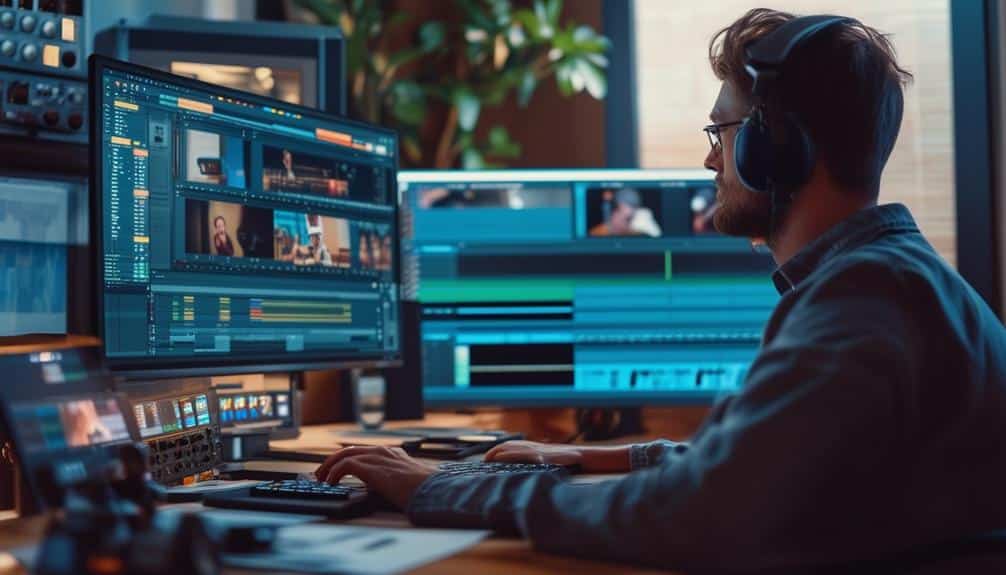Elevate Your Brand with Professional B2B Video Editing: Strategies and Trends

In the realm of B2B video production, the art of professional video editing can make or break the success of your content.
Imagine a tech company unveiling its latest product line through a series of promotional videos.
The key to these videos’ success lies in meticulous editing that highlights product features while maintaining brand identity.
This guide explores the intricacies of B2B video editing, from strategic workflows and collaborative feedback to advanced tools and innovative storytelling techniques.
Learn how professional editing can elevate your content, drive engagement, and enhance brand perception in a competitive digital landscape.
Table of Contents
Understanding B2B Video Editing
To excel in B2B video production, understanding the intricacies of video editing is paramount for creating compelling and impactful content.
The editing workflow in B2B video production involves a series of strategic steps that culminate in the final polished product. It begins with making creative decisions that align with the client’s vision and brand identity.
Collaborative processes play an essential role in ensuring that all stakeholders are involved in the decision-making process, leading to a cohesive and effective end result. Client feedback is an essential component of the editing workflow, allowing for adjustments to be made based on the client’s preferences and objectives.
Quality control is another critical aspect of B2B video editing, ensuring that the final product meets the highest standards of excellence. By meticulously reviewing every detail of the video, from replacements to audio levels, editors can guarantee that the content is flawless and engaging.
Incorporating these elements into the editing process leads to the creation of professional and impactful B2B videos that resonate with the target audience.
The Editing Process Explained

In the domain of B2B video production, mastering the editing process is like orchestrating a symphony of visual elements to craft a seamless and compelling narrative that captivates your audience.
The editing workflow in B2B video production involves meticulous attention to detail, strategic placement of shots, and creative transformations to enhance the overall visual storytelling.
Timeline organization is pivotal in ensuring a smooth editing process. By structuring your editing timeline effectively, you can easily navigate through footage, implement edits seamlessly, and maintain a cohesive flow in the final video production.
Client feedback plays an essential role in the editing process. By actively seeking and incorporating client input, you can tailor the video to meet their specific requirements and expectations. This iterative process leads to a collaborative approach that ensures the final product aligns with the client’s vision.
The revision process is where the magic truly happens. Fine-tuning transformations, adjusting pacing, and refining visual effects based on feedback culminate in a polished video ready for delivery.
Embrace the revision process as an opportunity to elevate your video production to new heights.
Tools and Software Essentials
For peak efficiency and precision in B2B video production, equipping yourself with the essential tools and software is paramount.
To achieve professional results, consider the following:
- Advanced Techniques: Utilize advanced editing techniques such as color grading, motion tracking, and audio enhancement to elevate the quality of your videos.
- Cutting-Edge Software: Invest in cutting-edge software like Adobe Premiere Pro, Final Cut Pro, or DaVinci Resolve for seamless editing processes and access to a wide range of editing tools.
- Creative Solutions: Experiment with different software plugins, effects, and transitions to add a creative flair to your videos and make them stand out from the competition.
Narrative Techniques for Engagement

Engage your audience effectively by weaving compelling narratives that captivate and resonate with viewers on a deeper level.
Storytelling techniques are key in creating a connection with your audience. Start by understanding your target audience to tailor the narrative to their interests and needs for maximum audience engagement.
Visual storytelling plays a significant role in conveying emotions and messages effectively. Use a mix of visuals, such as graphics, animations, and live-action shots, to enhance the storytelling experience and create an emotional connection with your viewers.
To maintain viewer engagement throughout the video, focus on creative shifts between scenes. Seamless shifts not only keep the audience interested but also enhance the overall viewing experience.
By incorporating creative shifts, you can guide the audience through the narrative smoothly, ensuring that they stay captivated from start to finish.
Color Grading in B2B Videos
Enhance the visual appeal and storytelling impact of your B2B videos through skillful color grading techniques that evoke specific moods and enhance overall coherence.
When it comes to color grading in B2B videos, there are several key aspects to take into account:
- Color Correction Techniques: Correcting color issues such as white balance, exposure, and contrast is vital to guarantee a consistent and professional look throughout your video.
- Creative Grading Styles: Experiment with various grading styles to find the one that best suits the tone and message of your video, whether it’s a vibrant and colorful palette or a more muted and cinematic feel.
- Color Theory Application: Understanding the basics of color theory can help you create harmonious color schemes that resonate with your audience and reinforce your brand identity.
Audio Enhancements and Effects
Utilize a combination of audio enhancements and effects to elevate the auditory experience of your B2B videos, guaranteeing clear communication and engaging content delivery.
Sound design plays a vital role in setting the mood and enhancing the overall viewing experience.
Through strategic audio mixing, you can balance different audio elements, such as background music, voiceovers, and sound effects, to create a harmonious blend. Incorporating special effects like echoes, reverbs, or dynamic range compression can add depth and interest to your audio, making it more immersive for the audience.
When it comes to voiceovers, make sure that they’re crisp, clear, and well-integrated with the visuals to convey your message effectively.
Foley art, the process of creating sound effects to enhance the audio realism, can bring a sense of authenticity to your videos. Pay attention to details like footsteps, door creaks, or rustling leaves to make the audio more lifelike.
By implementing these audio enhancements and effects thoughtfully, you can elevate the quality of your B2B videos and leave a lasting impact on your viewers.
Graphics and Text Integration
To seamlessly integrate graphics and text into your B2B videos, consider the strategic placement and design elements that will enhance the visual storytelling and convey your message effectively.
Here are some key aspects to focus on:
- Branding consistency: Assure that your graphics and text align with your brand’s visual identity, including colors, fonts, and overall style, to reinforce brand recognition throughout the video.
- Visual hierarchy: Create a visual hierarchy by using different sizes, colors, and placement of graphics and text to guide the viewer’s attention and emphasize important information effectively.
- Motion graphics: Incorporate dynamic motion graphics to add interest and engagement to your video, making complex information more digestible and memorable for your audience.
When selecting typography choices, opt for fonts that are easy to read and align with your brand’s tone. Finally, strategically place your call to action within the video to prompt viewers to take the desired next steps.
By carefully considering these elements, you can craft visually compelling B2B videos that effectively communicate your message and drive engagement.
Optimizing for Different Platforms

When adapting your B2B video content for different platforms, customize the format and messaging to suit the specific audience and user behavior on each platform.
To guarantee cross-platform compatibility, consider audience segmentation to deliver targeted content effectively. Content repurposing is vital; adjust video length, tone, and style to match the preferences of users on various platforms.
Utilize platform-specific formatting, such as optimizing video dimensions and resolution for each channel. By analyzing engagement metrics, you can determine which platforms require different editing approaches to enhance viewer interaction.
Understanding the nuances of each platform is essential for successful video editing in B2B productions. Always prioritize quality and relevance in your edits to maximize reach and impact across diverse platforms.
Future Trends in Video Editing
Explore the cutting-edge advancements shaping the future landscape of video editing in B2B content creation.
The future of video editing lies in AI-driven editing, where algorithms analyze vast amounts of data to make editing decisions that streamline the post-production process.
Virtual reality editing is set to revolutionize the way videos are created, allowing for immersive and interactive experiences.
Interactive storytelling will take center stage, enabling viewers to engage with content in new and exciting ways.
360-degree video technology will become more prevalent, offering viewers a truly immersive viewing experience that goes beyond traditional video formats.
Personalized content delivery will be key, with editing techniques that cater to individual viewer preferences, creating a more tailored and engaging experience.
Embracing these trends will be essential for businesses looking to stay ahead in the ever-evolving world of video production.
Frequently Asked Questions
Why is professional video editing crucial for B2B content?
Professional video editing is crucial for B2B content because it ensures that your videos are polished, engaging, and aligned with your brand’s identity.
Strategic editing can highlight key product features, simplify complex information, and create a cohesive narrative that resonates with your target audience. By incorporating client feedback and maintaining high standards of quality control, professional editors can produce videos that not only attract but also retain viewer attention.
This level of precision and attention to detail helps build trust and credibility with your audience, ultimately driving engagement and conversions.
What are the essential tools and software for B2B video editing?
Essential tools and software for B2B video editing include advanced editing programs like Adobe Premiere Pro, Final Cut Pro, and DaVinci Resolve.
These platforms offer a wide range of features such as color grading, motion tracking, and audio enhancement, which are crucial for creating professional-quality videos. Additionally, investing in plugins, effects, and transitions can add a creative flair to your projects.
High-quality microphones, audio recorders, and lighting equipment are also essential to ensure that both the visual and auditory elements of your videos are top-notch. Utilizing these tools allows for precise, efficient, and creative video production.
How can storytelling techniques improve B2B video engagement?
Storytelling techniques improve B2B video engagement by creating a narrative that resonates with viewers on an emotional level. Understanding your target audience and tailoring the narrative to their interests and needs is key.
Visual storytelling, using a mix of graphics, animations, and live-action shots, enhances the emotional connection and makes the content more relatable. Creative shifts between scenes and building suspense or curiosity can keep viewers engaged from start to finish.
Effective storytelling not only captures attention but also fosters a deeper connection with your brand, encouraging viewers to take the desired actions.
What role does color grading play in B2B video production?
Color grading plays a significant role in B2B video production by enhancing the visual appeal and storytelling impact of your videos.
Proper color correction ensures that all shots have consistent white balance, exposure, and contrast, giving your video a professional look. Creative grading styles can set the tone and mood of the video, whether it’s vibrant and colorful or more muted and cinematic.
Understanding color theory helps in creating harmonious color schemes that resonate with your audience and reinforce your brand identity. Skillful color grading can transform a good video into a visually stunning and emotionally engaging piece of content.
How can future trends in video editing impact B2B content creation?
Future trends in video editing, such as AI-driven editing, virtual reality, and interactive storytelling, are set to revolutionize B2B content creation.
AI-driven editing can streamline the post-production process by making intelligent editing decisions based on data analysis. Virtual reality and 360-degree video technology offer immersive experiences that go beyond traditional formats, allowing viewers to engage with content in new ways.
Interactive storytelling enables viewers to actively participate in the narrative, creating a more engaging and personalized experience.
Embracing these trends will help businesses stay ahead in the ever-evolving digital landscape, delivering innovative and impactful video content that captivates and converts their audience.
Share:
Search our blog:
Follow us on:
